A low-fat diet focuses on reducing fat intake to promote weight management and improve heart health. It emphasizes whole foods like fruits, vegetables, and lean proteins, helping to lower cholesterol and reduce the risk of chronic diseases. This approach is often recommended for individuals with specific health conditions, such as fatty liver or gallbladder issues. By incorporating nutrient-rich, low-fat options, individuals can maintain a balanced and satisfying diet while supporting overall well-being.
Overview of Low-Fat Diets
A low-fat diet is an eating plan that limits fat intake, particularly from saturated and trans fats, to promote better health outcomes. It focuses on whole, nutrient-rich foods like fruits, vegetables, lean proteins, and whole grains. Typically, a low-fat diet recommends that no more than 20-35% of daily calories come from fat, with an emphasis on unsaturated fats. This approach is often suggested for weight management, heart health, and managing conditions like fatty liver or gallbladder issues. By reducing fat intake, individuals can lower cholesterol levels and reduce the risk of chronic diseases. Low-fat diets are flexible and can be tailored to suit various lifestyles and preferences, making them a sustainable choice for long-term health improvement.
Benefits of a Low-Fat Diet
A low-fat diet offers numerous health benefits, including weight management and improved heart health by reducing cholesterol levels. It helps prevent chronic diseases like diabetes and certain cancers. By focusing on whole, nutrient-rich foods, this diet supports better liver function and enhances overall well-being. Additionally, it aids in managing digestive issues for those with conditions like IBS. The emphasis on unsaturated fats promotes a balanced intake while minimizing the risk of saturated fat-related health problems. This dietary approach is versatile and can be tailored to various needs, making it a sustainable choice for long-term health improvement.
Difference Between Low-Fat and Fat-Free Diets
A low-fat diet limits fat intake to 30% or less of daily calories, emphasizing reduced saturated fats, while a fat-free diet aims to eliminate fat entirely. Low-fat diets focus on whole, nutrient-rich foods like fruits, vegetables, lean meats, and whole grains, promoting balanced nutrition. Fat-free diets, however, often restrict even healthy fats, which are essential for brain function and nutrient absorption. Low-fat diets are more practical and sustainable, supporting weight management and heart health without extreme restrictions. They encourage mindful fat choices rather than complete elimination. Fat-free diets, while beneficial for specific conditions, may lead to nutrient deficiencies if not carefully planned. The key difference lies in their approach: low-fat allows moderate fat intake, while fat-free strives for near-zero fat consumption. Both aim to improve health but cater to different needs and lifestyles.

Food Groups in a Low-Fat Diet
A low-fat diet includes fruits, vegetables, whole grains, lean meats, poultry, fish, low-fat dairy, and healthy fats, focusing on nutrient-rich options to support overall health and weight management effectively.
Dairy Products
Dairy products play a significant role in a low-fat diet, offering essential nutrients like calcium and protein. Opt for skim milk, low-fat cheese, and nonfat yogurt, which are rich in benefits but low in fat. Avoid whole milk, cream, and high-fat cheeses. Incorporating fat-free sour cream and low-fat milk into meals can enhance flavor without adding excess fat. These choices support heart health and weight management while providing the necessary nutrients for a balanced diet. Always check food labels to ensure the products align with your low-fat goals.
Lean Meats and Poultry
Lean meats and poultry are excellent sources of protein in a low-fat diet. Opt for skinless chicken and turkey breast, as they are low in fat and rich in nutrients. Avoid processed meats like hot dogs and sausages, which are high in fat and sodium. Choose lean cuts of beef or pork, such as sirloin or tenderloin, and trim visible fat before cooking. Eggs can also be included, using egg whites or low-cholesterol egg substitutes to reduce fat intake. When preparing, avoid frying and instead bake, grill, or roast to keep meals healthy. Incorporating these options ensures a balanced intake of protein while maintaining low fat consumption, supporting overall health and weight management. Always check labels or consult a dietitian for the best choices.
Whole Grains
Whole grains are a cornerstone of a low-fat diet, offering essential nutrients and fiber while keeping fat content low. Opt for oats, quinoa, brown rice, whole wheat bread, and whole grain pasta. These foods are naturally low in fat but rich in vitamins, minerals, and dietary fiber, which support digestion and overall health. Choose high-fiber cereals for breakfast, as they are typically low in fat and provide sustained energy. Avoid refined grains like white bread or white rice, as they lack the nutritional benefits of whole grains. Incorporating whole grains into meals helps maintain a balanced diet, supports healthy weight management, and reduces the risk of chronic diseases. Always check labels to ensure the product is 100% whole grain and low in added fats or sugars.
Fruits and Vegetables
Fruits and vegetables are essential components of a low-fat diet, providing vital nutrients while maintaining minimal fat content. Incorporate a variety of fruits such as apples, berries, citrus fruits, and stone fruits, which are naturally low in fat and rich in vitamins and antioxidants. Similarly, include a wide range of vegetables, including leafy greens, broccoli, carrots, and bell peppers, all of which are fat-free and packed with fiber and essential minerals. These foods help promote overall health, support healthy digestion, and can reduce the risk of chronic diseases. Opt for fresh, raw, or steamed options to avoid adding unnecessary fats. Incorporating a colorful mix of fruits and vegetables ensures a balanced and nutritious low-fat diet, making meals both satisfying and healthy. Always choose whole forms instead of juices to maximize dietary benefits.
Healthy Fats
While minimizing fat intake is central to a low-fat diet, incorporating healthy fats is crucial for overall well-being. These fats, such as monounsaturated and polyunsaturated fats, support heart health and provide essential fatty acids the body cannot produce. Avocados, nuts, and seeds are excellent sources of healthy fats and should be consumed in moderation. Olive oil and fatty fish like salmon and mackerel are also recommended, as they offer omega-3 fatty acids that reduce inflammation and improve brain function. For dairy, opt for low-fat or fat-free options to enjoy the benefits of calcium without excessive fat. These fats enhance the flavor and satisfaction of meals while supporting a balanced diet. Always choose unsalted and unroasted varieties to minimize sodium and added fats. Incorporating healthy fats mindfully ensures a nutritious and satisfying low-fat diet. Avoid processed foods high in unhealthy fats to maintain optimal health benefits.
Snacks and Sweets
Incorporating healthy snacks and sweets into a low-fat diet can satisfy cravings without compromising nutritional goals. Opt for fresh fruits like berries, apples, or citrus, which are naturally low in fat and rich in fiber. Raw or roasted vegetables, such as carrots, bell peppers, or broccoli, paired with hummus or guacamole, make delicious and nutritious snacks. Whole grain crackers with low-fat spreads or a small handful of nuts and seeds are also great options. For sweets, choose fruit-based desserts, dark chocolate with at least 70% cocoa, or low-fat yogurt with honey. Avoid processed snacks high in saturated fats, added sugars, and sodium. These choices ensure snacks and sweets remain enjoyable while aligning with a low-fat dietary plan.

Meal Planning and Recipes
Effective meal planning is key to maintaining a low-fat diet. Start by organizing weekly meals, ensuring a variety of nutrient-rich ingredients like lean proteins, whole grains, and vibrant vegetables. Use healthy recipes that incorporate cooking methods such as baking, grilling, or steaming to minimize fat. Opt for herbs and spices for flavor instead of oils or butter. Plan balanced breakfasts, lunches, and dinners, and prepare snacks in advance to avoid unhealthy choices. Refer to guides or PDF resources for inspiration and practical tips to keep your meals both delicious and low in fat. Consistency and creativity in meal planning can make adhering to a low-fat diet enjoyable and sustainable.
Breakfast Ideas
Starting your day with a nutritious, low-fat breakfast is essential for energy and weight management. Options like steel-cut oats with skim milk and fresh fruits provide sustained energy without excess fat. Whole grain cereals with berries or sliced bananas are also excellent choices. For protein, consider egg whites or low-fat yogurt topped with granola and a drizzle of honey. Incorporate lean meats like turkey bacon or a slice of ham for added protein. Smoothies made with spinach, berries, and nonfat yogurt are a quick and healthy option. Avoid high-fat additives like butter, cheese, or creamy spreads. Opt for whole grain toast with jam or avocado slices for a satisfying start. These breakfast ideas are not only delicious but also align with a low-fat diet, helping you stay on track with your health goals.
Lunch Options
A healthy, low-fat lunch can be both satisfying and nutritious. Consider options like grilled chicken breast with a side of steamed vegetables or a hearty salad with mixed greens, lean turkey, and a light vinaigrette. Whole grain wraps or sandwiches with low-fat mayo and plenty of veggies are great choices. For plant-based meals, lentil soup or quinoa bowls with roasted vegetables and a drizzle of olive oil are excellent. Incorporate fish like salmon or cod for a boost of omega-3 fatty acids. Avoid fried or processed foods, opting instead for baked or poached options. Pair your meal with a side of fruit or a small portion of low-fat yogurt for added satisfaction. These lunch ideas are designed to keep you energized while maintaining a balanced, low-fat diet.
Dinner Recipes
For a delicious and healthy dinner, consider baked salmon seasoned with herbs and lemon, served alongside roasted vegetables like asparagus and bell peppers. Another option is grilled chicken breast paired with quinoa and a medley of steamed greens. Vegetable stir-fries with tofu and brown rice are not only flavorful but also packed with nutrients. Use minimal oil and enhance flavors with garlic, ginger, and low-sodium soy sauce. For a hearty meal, try lentil soup with whole grain bread or a stuffed bell pepper with lean ground turkey and brown rice; These recipes are designed to be low in fat while providing a satisfying and balanced meal. Incorporate a variety of colors and textures to ensure a diverse intake of vitamins and minerals. These dinner ideas support a healthy lifestyle and can be easily customized to suit your taste preferences.
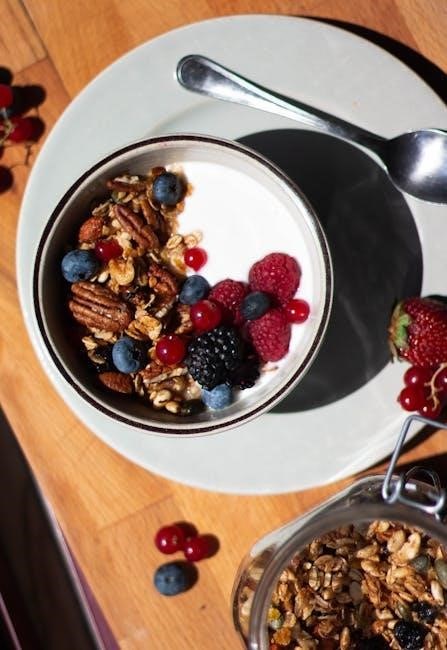
Health Benefits of a Low-Fat Diet
A low-fat diet supports heart health by reducing cholesterol and blood pressure. It aids in weight management and improves liver function, while also lowering the risk of chronic diseases.
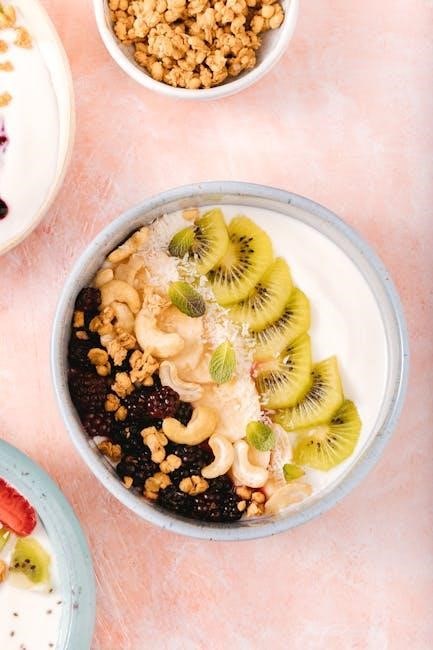
Heart Health
A low-fat diet plays a crucial role in maintaining heart health by reducing the risk of cardiovascular diseases. By limiting intake of saturated and trans fats, it helps lower LDL cholesterol and blood pressure, both key factors in heart disease. Incorporating fruits, vegetables, whole grains, and lean proteins supports overall cardiac well-being. Avoiding high-fat foods prevents plaque buildup in arteries, improving blood flow and reducing the likelihood of heart attacks or strokes. Regularly consuming omega-3 fatty acids from fish like salmon or mackerel further enhances heart health. This dietary approach not only protects the heart but also promotes a longer, healthier life. By adhering to a low-fat diet, individuals can significantly reduce their risk of developing cardiovascular conditions, making it a sustainable choice for long-term heart health.
Weight Management
A low-fat diet is an effective strategy for weight management, as it reduces overall calorie intake while promoting feelings of fullness. By focusing on low-fat foods like fruits, vegetables, lean meats, and whole grains, individuals can maintain a calorie deficit necessary for weight loss. These foods are naturally lower in energy density, allowing for larger portions without excessive calorie consumption. Additionally, avoiding high-fat snacks and sweets helps curb unnecessary weight gain. Portion control and mindful eating are essential to ensure the diet remains balanced. Over time, a low-fat diet can lead to sustainable weight management by fostering healthier eating habits and reducing reliance on high-calorie, high-fat foods. This approach not only supports weight loss but also helps maintain a healthy weight long-term.
Liver Function
A low-fat diet is often recommended to support liver function, particularly for individuals with liver conditions such as fatty liver disease or cirrhosis. Excessive fat intake can overload the liver, impairing its ability to process nutrients and detoxify the body. By reducing dietary fat, especially from processed and fried foods, the liver can function more efficiently. Foods like lean proteins, whole grains, and fresh vegetables are ideal, as they provide essential nutrients without adding unnecessary strain. Avoiding high-fat snacks and sugary foods further supports liver health. A well-planned low-fat diet can help reduce liver inflammation and promote overall well-being. This dietary approach is often prescribed by healthcare professionals to manage conditions like non-alcoholic fatty liver disease (NAFLD) and ensure optimal liver function. Regular monitoring and adherence to the diet are crucial for long-term benefits.
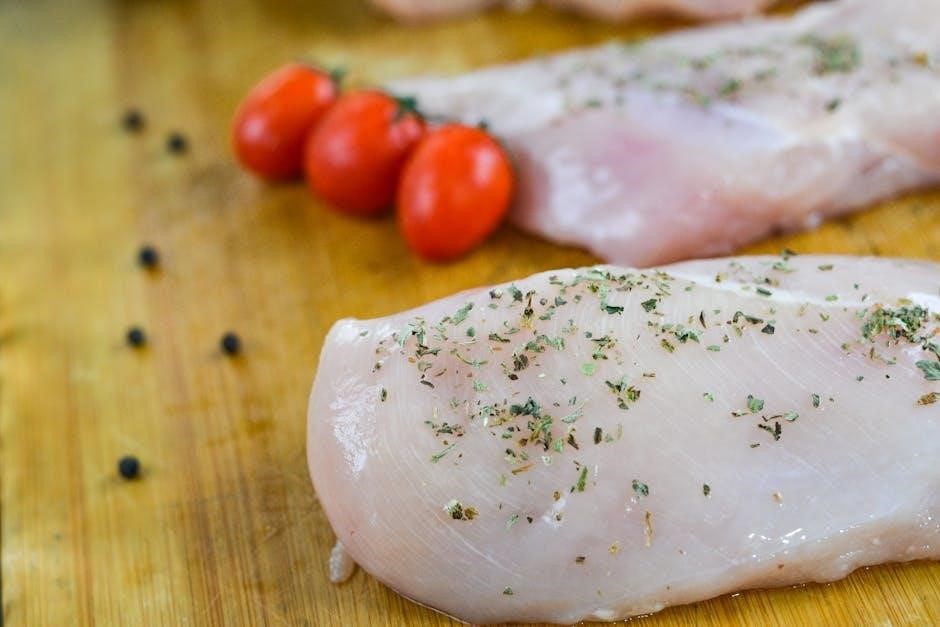
Grocery Shopping Tips
When shopping for a low-fat diet, focus on whole, unprocessed foods like fruits, vegetables, lean meats, and whole grains. Always read food labels to check fat content and choose products with less than 3g of fat per serving. Opt for low-fat dairy and reduced-fat versions of snacks. Avoid processed and fried foods, which are typically high in unhealthy fats. Plan your meals in advance to ensure you buy only what you need, reducing waste and temptation. Stick to your shopping list and shop the perimeter of the store, where healthier options are usually located.
Reading Food Labels
Reading food labels is essential for managing a low-fat diet. Start by checking the nutrition facts panel for total fat content, calories, and serving size. Look for products with less than 3g of fat per serving. Pay attention to the percentage of daily value (%DV) for fat, aiming for 5% or less for low-fat options. Be aware of different types of fat, such as saturated, trans, and unsaturated fats, as saturated and trans fats should be minimized. Ingredients are also key—avoid products listing fats, oils, or lard near the top. Watch for hidden fats in processed foods, snacks, and sauces. Use the “Nutrition Facts” to compare brands and choose the lowest-fat options. Always check for certifications like “low-fat” or “reduced-fat” to make informed choices. This step ensures your grocery selections align with your dietary goals.
Choosing the Right Products
Selecting the right products is crucial for a successful low-fat diet. When shopping, prioritize whole, unprocessed foods like fruits, vegetables, lean meats, and whole grains. For packaged items, always read the nutrition label to ensure the product contains less than 3g of fat per serving. Opt for low-fat or nonfat versions of dairy products, such as skim milk or nonfat yogurt. Choose lean meats like poultry without skin or fish, and avoid processed meats like hot dogs or sausages.
Avoid foods with added fats, such as fried items, pastries, or high-fat snacks. Select whole grains over refined ones, as they provide more nutrients and fiber. Be cautious of hidden fats in sauces, dressings, and gravies. By making informed choices, you can build a balanced and satisfying low-fat diet.

Cooking Tips for Low-Fat Meals
Use healthy cooking methods like grilling, roasting, or steaming to avoid adding extra fat. Opt for herbs and spices to flavor dishes instead of oils or butter. Substitute ingredients like applesauce for oil in baked goods to reduce fat content while maintaining moisture and taste. These strategies help create delicious, low-fat meals without sacrificing flavor.
Healthy Cooking Methods
Adopting healthy cooking methods is essential for preparing low-fat meals that are flavorful and nutritious. Grilling, roasting, and steaming are excellent techniques that avoid adding extra fat. Use herbs, spices, and marinades to enhance flavor without relying on oils or butter. Baking or broiling lean meats and fish is another great way to keep dishes low in fat. For sautéing, opt for small amounts of heart-healthy oils like olive or avocado oil. Additionally, substituting ingredients like applesauce or yogurt for butter in baked goods can reduce fat content while maintaining moisture. These methods not only support a low-fat diet but also promote overall health and well-being. By incorporating these strategies, you can enjoy satisfying meals without compromising on taste.
Reducing Fat in Recipes
Reducing fat in recipes is a simple way to make meals healthier while maintaining flavor. Substitute high-fat ingredients with lower-fat alternatives, such as using applesauce instead of oil or butter in baked goods. Choose lean meats and poultry without skin, and opt for low-fat dairy products like skim milk or nonfat yogurt. Egg whites can replace whole eggs to cut down on saturated fat. When cooking, use small amounts of healthy oils like olive or avocado oil for flavor. Incorporate herbs, spices, and vinegar for added taste without extra fat. Select low-fat snacks and sweets, such as fruit or dark chocolate with at least 70% cocoa. Reading food labels helps identify low-fat options, ensuring your recipes align with your dietary goals. These adjustments make meals more nutritious while keeping them satisfying and delicious.
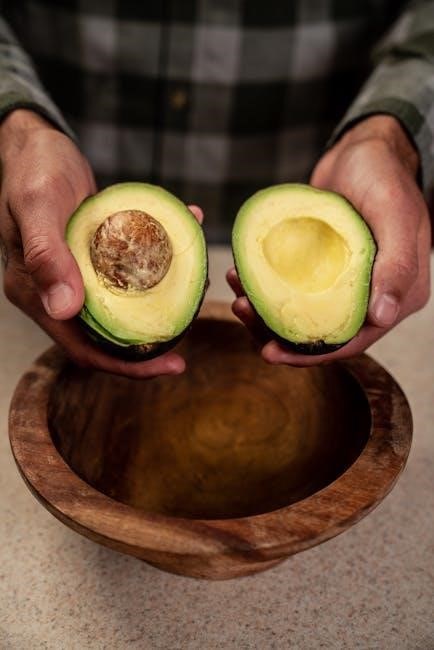
PDF Resources for Low-Fat Diets
Downloadable PDF guides provide detailed low-fat food lists and practical tips for reducing fat intake. These resources help plan balanced meals and support long-term health goals effectively.
Downloadable Food Lists and Guides
Downloadable PDF resources offer comprehensive low-fat food lists and guides to help individuals plan and manage their diets effectively. These resources often include detailed meal plans, shopping tips, and nutritional advice to support weight management and overall health.
For example, a 5-day low-fat diet menu provides structured breakfast, lunch, and dinner options, ensuring meals are balanced and nutrient-rich. Additionally, guides like the Enjoy and Avoid Booklet list foods to include and avoid, making it easier to make healthy choices.
These PDF documents are designed to be user-friendly, offering practical strategies for reducing fat intake and maintaining a satisfying diet. They are particularly useful for individuals with specific health conditions, such as fatty liver disease, who require tailored dietary advice.
By utilizing these resources, individuals can gain clarity and confidence in their dietary decisions, ensuring they stay on track with their low-fat diet goals.
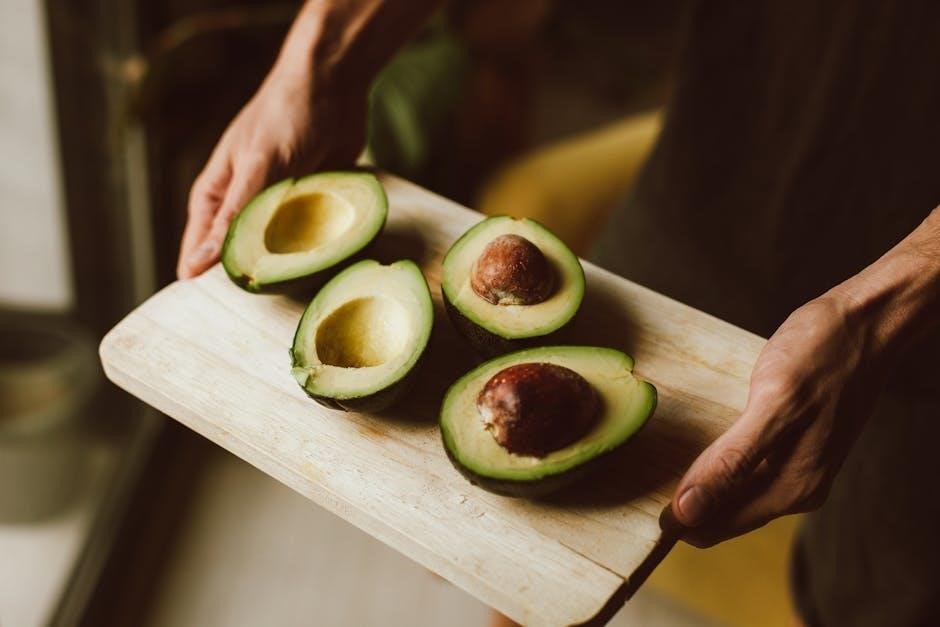
Maintaining Motivation
Tracking progress, setting achievable goals, and using PDF guides can help stay motivated on a low-fat diet. These resources provide clear direction and encouragement for long-term success.
Sticking to Your Diet Plan

Consistency is key to maintaining a low-fat diet. Using a PDF food list can help identify healthy options, ensuring meals remain balanced and satisfying. Planning weekly menus and grocery shopping with a structured list prevents impulsive choices. Tracking daily intake with a food diary or app also enhances accountability. Celebrating small milestones, like reaching a week without high-fat foods, boosts motivation. Surrounding yourself with supportive friends or joining a diet group can further encourage adherence. Remember, gradual changes lead to sustainable results, making it easier to stick with the plan long-term.
